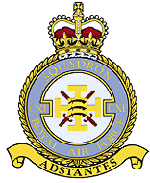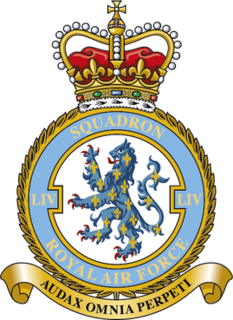| Arabian Peninsular Reconnaissance Flight RAF | |
|---|---|
 | |
| Active | 1 August 1959 – 1 October 1959 October 1959 - April 1960 [1] |
| Role | Tactical Reconnaissance [1] |
| Garrison/HQ | RAF Khormaksar |
| Equipment | Gloster Meteor FR.9 [1] |
| Arabian Peninsular Reconnaissance Flight RAF | |
|---|---|
 | |
| Active | 1 August 1959 – 1 October 1959 October 1959 - April 1960 [1] |
| Role | Tactical Reconnaissance [1] |
| Garrison/HQ | RAF Khormaksar |
| Equipment | Gloster Meteor FR.9 [1] |
From 1956 Gloster Meteor FR Mk.9 aircraft from No. 208 Squadron RAF were deployed to Aden for operations against rebel tribesmen and Yemeni insurgents. This Squadron was withdrawn at the time of the Suez Crisis. 'C' Flight 208 Squadron returned in 1958 and was re-designated as the Aden Protectorate Reconnaissance Flight, formed on 1 August 1959, flying Meteor FR.9's. This flight was disbanded and renamed Arabian Peninsular Reconnaissance Flight on 1 October 1959.
The Arabian Peninsular Reconnaissance Flight was formed at RAF Khormaksar when the Aden Protectorate Reconnaissance Flight was dis-banded and renamed on 1 October 1959. The flight continued to fly the Meteor FR.9's on tactical reconnaissance missions until it was disbanded in April 1960, handing the tactical recce mission over to No. 8 Squadron RAF, flying Hawker Hunter FR.10's. [1] [2] 
The APRF was absorbed into 8 Squadron in August 1960 as B Flight. The Meteor FR.9s continued to serve the Squadron until gradual replacement by Hunter FR.10s during the spring and summer of 1961. The last Meteor operational sortie of an 8 Squadron Meteor FR.9 was flown in late July 1961.

The Gloster Meteor was the first British jet fighter and the Allies' only jet aircraft to achieve combat operations during the Second World War. The Meteor's development was heavily reliant on its ground-breaking turbojet engines, pioneered by Frank Whittle and his company, Power Jets Ltd. Development of the aircraft began in 1940, although work on the engines had been under way since 1936. The Meteor first flew in 1943 and commenced operations on 27 July 1944 with No. 616 Squadron RAF. The Meteor was not a sophisticated aircraft in its aerodynamics, but proved to be a successful combat fighter. Gloster's 1946 civil Meteor F.4 demonstrator G-AIDC was the first civilian-registered jet aircraft in the world. Several major variants of the Meteor incorporated technological advances during the 1940s and 1950s. Thousands of Meteors were built to fly with the RAF and other air forces and remained in use for several decades.

The Gloster Javelin is a twin-engined T-tailed delta-wing subsonic night and all-weather interceptor aircraft that served with Britain's Royal Air Force from the mid-1950s until the late 1960s. The last aircraft design to bear the Gloster name, it was introduced in 1956 after a lengthy development period and received several upgrades during its lifetime to its engines, radar and weapons, which included the De Havilland Firestreak air-to-air missile.

Number 8 Squadron of the Royal Air Force last operated the Boeing E-3D Sentry AEW1 (AWACS) from RAF Waddington, Lincolnshire. As of 2020, the RAF AWACS fleet was made up of three Sentry AEW1s, down from seven originally ordered in the late 1980s. Purusant to the 2021 defence review, the E-3D Sentry aircraft made its final flight in U.K. service in August 2021.

No. 4 Squadron, normally written as IV Squadron, of the Royal Air Force operates the BAE Hawk T2 in the training role from RAF Valley.

Number 43 Squadron, nicknamed the Fighting Cocks, was a Royal Air Force aircraft squadron originally formed in April 1916 as part of the Royal Flying Corps. It saw distinguished service during two world wars, producing numerous "aces". The squadron last operated the Panavia Tornado F3 from RAF Leuchars, Scotland, in the air defence role, until it was disbanded in July 2009.

Number 111 (Fighter) Squadron, also known as No. CXI (F) Squadron and nicknamed Treble One, was a squadron of the Royal Air Force. It was formed in 1917 in the Middle East as No. 111 Squadron of the Royal Flying Corps during the reorganisation of the Egyptian Expeditionary Force after General Edmund Allenby took command during the Sinai and Palestine Campaign. The squadron remained in the Middle East after the end of the First World War until 1920 when it was renumbered as No. 14 Squadron.

Number 54 Squadron is a squadron of the Royal Air Force based at RAF Waddington, Lincolnshire. On 1 September 2005, it took on the role of Intelligence, Surveillance and Reconnaissance (ISR) Operational Conversion Unit, and is currently responsible for training all RAF crews assigned to the MQ-9A Reaper, Shadow R1/R2, RC-135W Rivet Joint and Poseidon MRA1. It also controls the RAF ISR Warfare School (ISRWS) who run the Qualified Weapons Instructor Intelligence, Surveillance and Reconnaissance and QWI Reaper Courses.

No. 34 Squadron RAF was a squadron of the Royal Air Force. During the First World War it operated as a reconnaissance and bomber squadron and in the 1930s operated light bombers. It was re-equipped with fighter-bombers in the later half of the Second World War and in the post-war period was reformed four times; first as a photo-reconnaissance unit, then anti-aircraft co-operation, then as a jet fighter squadron through the 1950s. It was last active in the 1960s, as a Blackburn Beverley transport squadron.

Number 56 Squadron, nicknamed the Firebirds for their ability to always reappear intact regardless of the odds, is one of the oldest and most successful squadrons of the Royal Air Force, with battle honours from many of the significant air campaigns of both the First and Second World Wars.

No 208 (Reserve) Squadron was a reserve unit of the Royal Air Force, most recently based at RAF Valley, Anglesey, Wales. It operated the BAe Hawk aircraft, as a part of No. 4 Flying Training School. Due to obsolescence of its Hawk T.1 aircraft compared to the new-build Hawk T.2 aircraft of its sister unit, 4(R) Sqn, the squadron was disbanded in April 2016, in its 100th year of operations.

No. 226 Operational Conversion Unit was a Royal Air Force Operational Conversion Unit which was active between 1946 and 1991.

No. 26 Squadron of the Royal Air Force was formed in 1915 and was disbanded for the last time in 1976.

Number 72 (Fighter) Squadron of the Royal Air Force is a training squadron that is currently based at RAF Valley using the Beechcraft Texan T.1 to deliver Basic Fast Jet Training (BJFT).

No. 257 Squadron RAF was a flying squadron of the Royal Air Force active during the First World War, the Second World War and also the Cold War. It was finally disbanded in December 1963.

Royal Air Force Khormaksar or more simply RAF Khormaksar was a Royal Air Force station in Aden, Yemen. Its motto was "Into the Remote Places". During the 1960s, it was the base for nine squadrons and became the RAF's busiest-ever station as well as the biggest staging post for the RAF between the United Kingdom and Singapore.

No. 79 Squadron was a squadron of the Royal Air Force.
British Forces Aden was the name given to the British Armed Forces stationed in the Aden Protectorate during part of the 20th century. Their purpose was to preserve the security of the Protectorate from both internal threats and external aggression.
No 81 Squadron was a squadron of the Royal Air Force. It flew Fighter aircraft during the Second World War, and reconnaissance aircraft in the Far East after the war and was disbanded in 1970.

No. 1417 Flight RAF was an independent flight of the Royal Air Force which existed between 1941 and 1993 at various times in a variety of roles. This Flight had probably the most interesting incarnations of all the independent aircraft flights of the Royal Air Force, introducing new technologies and operating complex fast jet aircraft in challenging and austere conditions, from the Arabian Peninsula to Central America.
No 91 (Nigeria) Squadron was a squadron of the Royal Air Force but is no longer operational. The name acknowledges the contribution made by Nigeria to the cost of the squadron's aeroplanes.